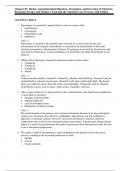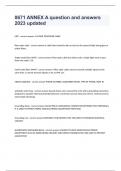Chapter 01: Intake: Gastrointestinal Digestion, Absorption, and Excretion of Nutrients
Raymond: Krause and Mahan’s Food and the Nutrition Care Process, 16th Edition
MULTIPLE CHOICE
1. Pepsinogen is converted to pepsin when it comes in contact with
a. enterokinase.
b. trypsinogen.
c. hydrochloric acid.
d. peptidases.
ANS: C
Pepsinogen is secreted in the stomach and converted to its active form by the acid
environment of the stomach. Enterokinase is secreted by the brush border of the small
intestine in response to the presence of chyme. Trypsinogen is secreted by the pancreas and
activated by enterokinase. Various peptidases are secreted by the either brush border or the
pancreas.
2. Which of the following is formed by bacterial synthesis in the colon?
a. Vitamin K
b. Vitamin D
c. Vitamin B6
d. Niacin
ANS: A
Colonic bacteria produce vitamin K, vitamin B12, thiamin, and riboflavin. Vitamin D may be
metabolized by exposure of precursor vitamin D in the skin to ultraviolet light. The human
body can synthesize niacin from the amino acid tryptophan. Vitamin B 6 must be obtained
from dietary sources such as meats, whole grains, vegetables, and nuts.
3. After surgical removal of a large portion of the small intestine, what functional complication
is most likely to develop?
a. Changes in dietary habits
b. Impaired digestion
c. Loss of absorptive tissue
d. Elimination of dietary residue
ANS: C
The small intestine is the primary site of nutrient absorption because of its large absorption
surface area. Secretions from the liver, gallbladder, and pancreas can still contribute to
digestion of intestinal contents. However, decreased absorption of nutrients and food
components may result in more intestinal remains and residue. A patient may change dietary
habits as a result of gastrointestinal discomfort experienced after intestinal resection, but this
is not a functional complication.
4. The sight or smell of food produces vagal stimulation of the parietal cells of the gastric
mucosa, resulting in the increased production of what?
a. Motilin
b. Gastrin
c. Cholecystokinin
, d. Secretin
ANS: B
Parasympathetic innervation that causes secretion of gastrin and release of hydrochloric acid
helps prepare the stomach for the potential of receiving food. After food chyme is passed into
the small intestine from the stomach, secretin and cholecystokinin are secreted to stimulate
pancreatic secretion of water and bicarbonate. They also signal gallbladder contractions and
colonic motility, all resulting in reductions in stomach emptying and duodenal motility.
Motilin is secreted from the duodenal mucosa during fasting to stimulate gastric emptying and
intestinal motility.
5. If a patient experiences malabsorption of fat resulting from an impaired ability to produce
adequate bile salts for micelle formation, how may fat absorption be improved?
a. By increasing short-chain fatty acids in the diet
b. By increasing medium-chain fatty acids in the diet
c. By increasing long-chain fatty acids in the diet
d. By restricting dietary intake of cholesterol
ANS: B
Medium-chain fatty acids of 8 to 12 carbons can be absorbed directly by mucosal cells
without the presence of bile. The long-chain fatty acids require micelle formation for
absorption. Short-chain fatty acids result from bacterial fermentation of malabsorbed
carbohydrates and fibers. As bile is produced from cholesterol, dietary restriction of
cholesterol is negligible in regard to improvements in fat absorption.
6. What is the function of secretin?
a. Stimulation of gastric secretions and increased motility
b. Stimulation of gallbladder contraction and the release of bile
c. Stimulation of the pancreas to secrete water and bicarbonate
d. Stimulation of the parietal cells to secrete gastrin
ANS: C
Secretin is the hormone that works in opposition to gastrin. Whereas gastrin stimulates
stomach digestion activities, secretin decreases gastric output and promotes pancreatic
secretions to neutralize the acidity of chyme. Cholecystokinin is also secreted when chyme
enters the duodenum, and it is responsible for stimulating the gallbladder.
7. Which of the following is a list of enzymes released from the pancreas?
a. Insulin, trypsin, and secretin
b. Lactase, isomaltase, and dextrinase
c. Protease, pepsin, and gastrin
d. Trypsin, chymotrypsin, and carboxypeptidase
ANS: D
Trypsin, chymotrypsin, and carboxypeptidase are three protein digestive enzymes secreted by
the pancreas. Insulin is an endogenous hormone secreted by the pancreas. Secretin is a
hormone secreted by the small intestine. Lactase and isomaltase (also known as dextrinase)
are brush-border enzymes. Pepsin, which is a protease, and gastrin are hormones secreted by
the stomach.
8. In what form is dietary fat absorbed from the lumen of the intestine?
, a. Chylomicron
b. Micelle
c. Triglyceride
d. Lipoprotein
ANS: B
Fats must be emulsified into micelles so that they may cross the unstirred water layer that
borders the brush-border membranes. These micelles leave monoglycerides and fatty acids at
the brush border, where they are reabsorbed and reassembled as triglycerides. The
triglycerides are packaged with cholesterol, fat-soluble vitamins, and phospholipids into
chylomicrons, which pass into the lymphatic circulation. When these reach the liver, the
chylomicron components are repackaged into low-density lipoproteins.
9. Which of the following is true of probiotics?
a. Probiotics are live microorganisms found in food.
b. Probiotics are nondigestible carbohydrates.
c. Probiotics act primarily on bacteria in the proximal small intestine.
d. Probiotics cannot be given as supplements because they readily die.
ANS: A
Probiotics are live microorganisms, which when administered in adequate amounts confer a
health benefit on the host. They are found in fermented foods like yogurt and sauerkraut or as
a nutritional supplement. Bacterial action is most intense in the distal small intestine and large
intestine.
10. By which transport mechanism are most vitamins absorbed from the small intestine into the
blood?
a. Passive diffusion
b. Active diffusion
c. Facilitative diffusion
d. Passive osmosis
ANS: A
Passive diffusion is limited by the number of channels available for nutrients to randomly pass
through. Facilitated diffusion requires the presence of carrier proteins, which may be limited
by the health and nutritional status of the person. Active transport requires energy, which also
may be limited by the person’s health and nutritional status. Osmosis occurs in regard to
concentration gradient and only involves the movement of water, not vitamins.
11. What are primarily absorbed by the large intestine?
a. Water and fats
b. Carbohydrates
c. Proteins
d. Water and electrolytes
ANS: D
Water and electrolytes are usually the only absorbable remnants of dietary intake that reach
the large intestine. Fats, carbohydrates, and proteins from the diet are absorbed throughout the
small intestine.
12. What happens to cellulose and lignin as they go through the GI tract?
, a. They are converted into glucose before absorption.
b. They are converted into glucose and absorbed by active transport.
c. They are excreted in the feces unchanged.
d. They are excreted in the feces as glucose.
ANS: C
In humans, the secreted amylases cannot split the 1-2 and 1-4 linkages between the
saccharides within the cellulose molecule. As a result, no individual glucose molecules are
broken off.
13. Which is the process by which minerals are absorbed when they are bound to an acid, organic
acid, or amino acid?
a. Cotransportation
b. Carrier protein
c. Competitive inhibition
d. Chelation
ANS: D
Chelation refers to the binding of a cation mineral to a ligand, not a whole protein.
Cotransporters carry two different minerals at a time, such as the case with sodium and
phosphorus. An overlap of mineral transport mechanisms may lead to competitive absorption
between minerals in the presence of other minerals, such as the case with iron or zinc
supplementation, leading to a decrease in copper absorption.
14. How often do the cells lining the intestinal tract recycle?
a. Every 2 to 3 days
b. Every 3 to 5 days
c. Every 5 to 7 days
d. Every 10 to 14 days
ANS: B
Intestinal mucosal cells have a life span of 3 to 5 days before they are sloughed off and
recycled. They are fully functional only for the last 2 to 3 days as they migrate to the distal
third of the villi.
15. What effect may be achieved by eating a diet high in prebiotic carbohydrates?
a. Decreased SCFA production in the bowel
b. Increased growth of Lactobacillus spp.
c. Decreased absorption of bile salts
d. Increased absorption of cation minerals
ANS: B
The use of prebiotic carbohydrates favors the growth of friendly bacteria such as lactobacilli
and bifidobacteria. These bacteria ferment the prebiotic carbohydrates, promoting increased
short-chain fatty acid production. These types of carbohydrates have not been demonstrated to
have a bile-sequestering effect. Impairments in absorption of cation minerals tend to be in
relation to phytates and oxalates that are present in plant foods.
16. How long does it take for small intestine contents to reach the ileocecal valve?
a. 18 to 72 hours
b. 3 to 8 hours





